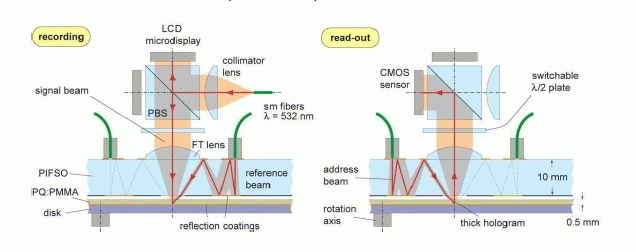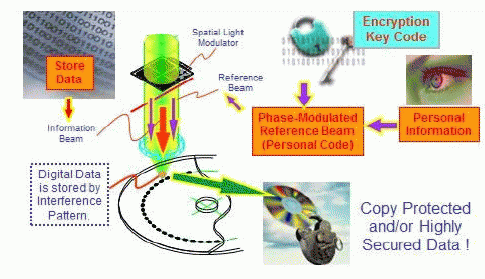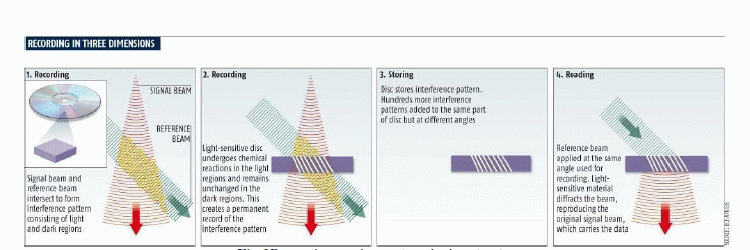Keywords
|
| hologrphic storage, holographic 3d disks, angle multiplexing, shift multiplexing, surface storage density. |
INTRODUCTION
|
| The hard disk drives are overflowing with data,even though a year earlier the same-sized seemed more than sufficient.The development of data storage devices is to keep up with this continuing demand for more capacity,more density,and faster readout rates.Improvements in conventional memory technologies-magnetic hard diskdrivers,optical disks,and semiconductor memories-have managed to keep pace with the demand for bigger,faster memories.However,strong evidence indicates that these two-dimensional surface-storage technologies are approaching fundamental limits that may be difficult to overcome,such as the wavelength of light and the thermal stability of stored bits.Later,3D memories came into existence with high density by superimposing many holograms within same volume of recording material.The inherent parallelism enables fast readout rates.1000 holograms are retrieved each second with million pixels in each.A hologram is a recording of the optical interference patter that forms at the intersection of two coherent optical beams.Typically,light from a single leaser is split into two paths,the signal path and the reference path. |
HOLOGRAMS
|
| A hologram is a recording of the optical interference pattern that forms at the intersection of two coherent optical beams. . Typically, light from a single laser is split into two paths, the signal path and the reference path. There are basically two types of holograms. A reflection hologram is viewed when lit from the front, while a transmission hologram is viewed by shining a light through it from the back side. An embossed hologram is made by backing a transmission hologram with a mirror-like substance, which allows it to be viewed when lit from the front. Holograms can also be made that show moving objects; these sequences, called stereograms, are typically three to 20 seconds long. |
DATA STORAGE
|
| In this technology ,for recording the digital data is impaired on to the obeject beam.At readout,data is retrieved from reconstructed object. The input device for the system is called a spatial light modulator or SLM.The SLM has 1000 pixels.Each pixels is an independent optical switch which either blocks or passes light.Output device is a similar array of detector pixels, such as a charge-coupled device (CCD) camera or CMOS pixel array. |
| The hologram can be formed anywhere in the imaging path between the input pixel array and the output pixel array. To maximize storage density, the hologram is usually recorded where the object beam attains a tight focus. When the reference beam reconstructs the hologram, the object beam continues along the original imaging path to the camera, where the optical output can be detected in parallel and converted to digital data. Capacity and readout rate are maximized when each detector pixel is matched to a single pixel on the SLM, but for large pixel arrays this requires careful optical design and alignment. |
STORAGE MATERIAL
|
| The hologram can be formed anywhere in the imaging path between the input pixel array and the output pixel array. To maximize storage density, the hologram is usually recorded where the object beam attains a tight focus. When the reference beam reconstructs the hologram, the object beam continues along the original imaging path to the camera, where the optical output can be detected in parallel and converted to digital data. Capacity and readout rate are maximized when each detector pixel is matched to a single pixel on the SLM, but for large pixel arrays this requires careful optical design and alignment. |
STORAGE MATERIAL
|
| Photosensitive materials for volume holography are generally classified as either read-write or write-once. |
• Read-write materials
|
| Most holographic read-write materials are inorganic photorefractive crystals doped with transition metals such as iron or rare-earth ions such as praseodymium, grown in large cylinders in the same way as semiconductor materials. Large samples can be cut and polished, making thick holograms possible. These materials react to the light and dark regions of an interference pattern by transporting and trapping photo-ionized electrons.Through the linear electro-optic effect exhibited by these crystals, the electrical fields created by the trapped charge give rise to an index or phase grating suitable for diffracting light. Thus, the spatial variations in light intensity present in the interference pattern become identical variations in the index of refraction. The trapped charge can be rearranged by subsequent illumination, which makes it possible to erase recorded holograms and replace them with new ones. However, the ease of charge reexcitation also results in the gradual erasure of stored holograms during normal readout. In the dark, the lifetime of these holograms ranges from months to years as the trapped charge slowly leaks away.Recorded holograms can be “fixed” (made semipermanent and resistant to erasure during readout) through thermal or electronic processes. The fixing process affects all the stored holograms within a volume simultaneously. Thus, individual pages of data cannot be erased and replaced this way. |
| • Write-once materialsWriting permanent volume holograms generally involves irreversible photochemical reactions, triggered by the bright regions of the optical interference pattern. For example, a photopolymer material will polymerize(bind short monomer chains together to form long molecular chains) in response to optical illumination. In contrast, the molecules in a photochromic material undergo a change in their absorption behavior. Such materials are inexpensive to make in quantity. However, both types can have problems reproducing the object beam faithfully—the photopolymer because of shrinkage, the photochromic because of oversensitivity to average local intensity. Careful system design can minimize these problems.One advantage of a photopolymer is that after recording, any leftover monomers can be disposed of without affecting the recorded holograms. A photochromic material, however, requires a separate chemical or optical step to disable the unused absorbing molecules after the holograms are recorded. Currently available versions of these write-once materials are thin (approximately 100 μm)—the difficulties in making thick samples include insufficient optical quality or excessive absorption. As we will show later, however, new multiplexing techniques for thin materials have made write-once photopolymers one of the leading candidates for the first holographic memory products. |
COMPACT MODULAR HOLOGRAPHIC MEMORY
|
| Bringing the pixel arrays for data input and output to the storage material is a better approach bringing beams to storage material as it is limited by beam steering optics. In fact, by applying a unique feature of the stored holograms, the same pixel array can be used for both input and output. Upon readout, If each pixel of the SLM is not only a light modulator but also a detector, then the entire storage device can be fabricated from identical compact modules with no moving parts. |
HOLOGRAPHIC 3D DISKS
|
| 1. The spatial multiplexing moves the storage material and leaves the optics and other components stationary.The thinkckness of disk is about 1mm due to which multiple holograms can be stored on the location of the surface.A number of radial tracks are available and the motion of head selects a track,thus the disk rotation provides access along each track.As the thinkness increases, a number of holograms can be added thus resulting in a proliferation in the surface density.However,the surface area illuminated also increases(may decrease the surface density).It would be desirable to fabricate the the disk of about 1mm so as to yield a density of approximately 100 bits per squared micron.Even though the data is stored in 3D disk it is the the surface density that matter and not the volme density for most practical purpose. |
| 2. The angle multiplexing is an other approach for multiplexing holograms on the holographic holograms.It would be convenient using a single and simple reference beam that could attain same density without a bulky deflector.This can be done by considering a converging or spherical beam which can be obtaing by brining in all the angles simultaneously instead of one at a time. |
SUMMARY
|
Future possiblities of holographic datastorage:
|
| • Erasable write-once, read-many drives supporting terabytes of storage, 1 Gbit/second readout rates, and fast access to data in blocks of 50–100Gbytes. Suitable applications include video on demand and large Web servers. |
| • Write-once 3D disks supporting more than 100Gbytes per 120-mm disk. Access time to 100-Mbyte blocks of 10– 100 milliseconds, with readout rates of more than 500 Mbits/sec. Suitable applications include archiving of data requiring permanent storage yet rapid access, such as medical data and high-resolution maps and satellite images. |
| • Pre-recorded 3D disks supporting more than 100Gbytes per 120-mm disk and readout rates greater than 200 Mbits/sec. Suitable applications include distributing computer programs, movies,and multimedia. |
Figures at a glance
|
 |
 |
 |
| Figure 1 |
Figure 2 |
Figure 3 |
|
| |
References
|
- F.H. Mok, G.W. Burr, and D. Psaltis, “System Metric for Holographic Memory Systems,” Optics Letters, June 1996, pp. 896-898.
- K. Blotekjaer, “Limitations on Holographic Storage Capacity of Photochromic and Photorefractive Media,” Applied Optics, June 1979, pp.57-67.
- M.A. Neifeld and M. McDonald, “Error Correction for Increasing the Usable Capacity of Photorefractive Memories,” Optics Letters, Sept. 1994, pp. 1,483-1,485.
- B.H. Olson and S.C. Esener, “Partial Response Precoding for Parallel Readout Optical Memories,” Optics Letters, May 1994, pp. 661-663.
- Selected papers on Holographic Storage, G.T. Sincerbox, edSPIE Milestone Series, Vol. MS 95, SPIE,Bellingham, Wash., 1994.
- A. Pu and D. Psaltis, “High-Density Recording in Photopolymer-Based Holographic Three-DimensionalDisks,” Applied Optics, May 1996, pp.2,389-2,398.
- G.Barbastathis, M. Levene, and D. Psaltis, “Shift Multiplexing with Spherical Reference Waves,” AppliedOptics, May 1996, pp. 2,403-2,417.
- G.W. Burr, Volume Holographic Storage Using the 90ºGeometry, doctoral dissertation, California Institute of Technology, Pasadena, Calif.,1996.
- M.-P.Bernal et al., “A Precision Tester for Studies of Holographic Optical Storage Materials and Recording Physics,” Applied Optics, May 1996, pp.2,360-2,37
|